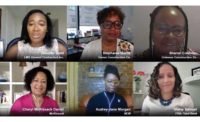Next April 7 will mark 42 years since President Jimmy Carter, responding to a lawsuit for noncompliance with Title VII of the 1964 Civil Rights Act, issued executive orders that opened construction jobs and apprenticeships to women.
Those bold, multipronged, result-oriented federal guidelines blueprinted an efficient path for women to become 25% of the construction workforce, ending its designation as a “non-traditional” occupation.

Major local and regional initiatives continued, but paper trails of “good-faith efforts” largely replaced federal efforts once Ronald Reagan took office in 1981, and before women like me—who entered industry in 1978—even completed our apprentice training.
U.S. statistics now show women making up 3.4% of craftworkers, 7.7% of industry managers and 10% of civil and mechanical engineers. Unless one believes men are 30 times more capable than women, construction is failing to employ its best potential workforce, and women don’t have full access to important middle-class careers they would enjoy.
I see cause for both optimism and concern.
Critical Mass
I’m encouraged that the industry itself now is taking the lead, addressing key issues: maternity leave, biased worksite behaviors, childcare and more. More unions and employers see the good economic sense and synergy of moving quickly to reach a critical mass of women in their workforce—at least 15%—a plateau that has jump-started new dynamics in other historically male occupations.
Last week I ran into a female electrician who worked her entire career for a union contractor that groomed her to grow with it. I congratulated her on her upcoming retirement with a solid pension. Women like her are invaluable, not just as role models, but also to advise on supports needed and obstacles to remove to achieve fair inclusion.
But she told me of a first-year apprentice carpenter who had asked for her advice on how to handle a foreman who repeatedly found “cause” to touch her, even tripping her so he could “catch” her—all in front of the crew, none of whom intervened.
Because no effective training or regulations with consequences were set for this predictable situation—a perpetrator more “valuable” and powerful than the victim—she was left to guess the best of bad choices while trying to advance her new career. I suggested she switch her trade and union. My friend had already done that.
Women today have options.
Rationale matters. If the industry recruits women because there aren’t enough available men, those women will be viewed—like World War II Rosies—as expendable, the ones to be laid off when work slows. Not groomed for core positions, their training will be short-changed.
Equal Terms
The affirmative action that opened gates for my generation had different problems, in part because it was short-lived.
It measured job hours and apprenticeship percentages rather than key assessments of whether the career path had really opened: journey-level and supervisory percentages, as well as comparative annual pay and accumulated pension years.
A more useful framework for inclusivity is to open careers to women on equal terms: recognizing they are an excellent workforce match for today’s industry and acknowledging that identical treatment, too, can be problematic.
A 6-ft ladder is not useful if one needs an 8-footer to reach the work spot; the same for ill-fitting protective equipment. It means recognizing that there are many ways to get a job done, that pregnancy and childcare are normal issues and that workplace culture should afford everyone dignity. The industry needs to view women as core to the workforce and reshape itself to allow their success.
Recruitment and retention are inseparable. Potential recruits check industry websites for women in leadership, gender-neutral language and welcoming policies. Retention starts day one, as a woman compares her treatment, training and advancement to that of others. Mentors should not advise on how to adapt to discrimination, but rather convey needed changes to those in leadership.
Gender demographics ahead are embedded in current practice. Today’s graduating craft apprentices and entry project managers and structural engineers are tomorrow’s jobsite and company leaders.
Gender equity is a major renovation project—requiring the creative problem-solving, dedicated resources and methodical follow-through that is the construction industry’s expertise and forté.
Susan Eisenberg is a resident scholar at Brandeis University, where she directs its On Equal Terms Project. A retired electrician and IBEW member, she is author of We’ll Call You If We Need You: Experiences of Women Working Construction (Cornell, 2018). Eisenberg can be reached at seis@brandeis.edu.




